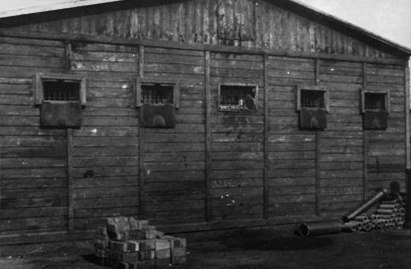Death and Executions
Death
Prisoners were confronted with death every day – they saw their dead and dying fellow prisoners, and they were in constant mortal danger themselves. The pungent smoke from the crematorium also constantly reminded them that violent death was a part of everyday life at the concentration camp. Prisoners were clubbed to death, drowned, hanged, shot, killed with poison gas or sadistically tortured to death. Prisoners also starved or perished because of the insufficient clothing and housing they received or because of the terrible hygienic conditions to which they were subjected. They died from lack of medical aid or medication or from exhaustion brought on by overwork and the constant maltreatment and harassment. Many lost the will to live and chose to kill themselves by crossing the guard cordon or by touching the electrically charged fence that surrounded the camp.
Executions and Murder Campaigns
In the spring of 1942, a medical commission visited the Neuengamme concentration camp and selected those who were "unable to work", Jews and other prisoners who were to be murdered with poison gas in the "euthanasia" killing center in Bernburg/Saale. In 1942, the SS introduced executions as a camp punishment, often in public on the parade ground. In the spring of 1943, large numbers of people in preventive detention who had been transferred by the judiciary were herded through the chain of guard posts. The Neuengamme concentration camp served as the central place of execution for police prisoners, and in August/September 1943 also for judiciary prisoners. They were shot at the sewage treatment plant or hanged in the detention bunker. Soviet prisoners of war who had been segregated in Wehrmacht camps because of the "commissar order" were also killed in Neuengamme; 448 of them were gassed with Zyklon B in two actions in autumn 1942.

Registration of deaths and disposal of corpses
Up until March 1941, the registry office in Neuengamme registered the deaths in Neuengamme concentration camp, until the concentration camp was given its own registry office (“Sonderstandesamt A”). In the mortuary, inmates under the direction of the SS dentist removed the gold from the teeth of the dead, which the Reichsbank received. Initially, an undertaker brought the dead to the municipal crematorium in the Ohlsdorf cemetery. The anatomical institutes of the university clinics in Hamburg-Eppendorf and Kiel received several hundred bodies. From 1941 the SS also had corpses cremated in a temporary crematorium near the camp, until 1942 when a crematorium was put into operation next to the main camp. It soon became too small, so a new crematorium went into operation in December 1944. Survivors report that the ashes of the deceased were scattered as fertilizer in the concentration camp garden center.
Record of death: The number of dead at Neuengamme concentration camp
Since the SS destroyed the files and documents of the administration of the Neuengamme concentration camp shortly before the end of the war, the exact number of dead cannot be given. By evaluating the preserved sources, it has been possible in recent years to estimate them more precisely. The names of around 20,400 people who died in Neuengamme concentration camp (including the satellite camps) before the start of the evacuation of the main camp at the end of March 1945 are known (including the executed Gestapo and judicial prisoners). The total number of dead by the end of March 1945 can be estimated at around 26,800. At least 16,100 people died during the evacuation marches and transports to the reception camps (excluding the Bergen-Belsen concentration camp) and during the bombardment of the prisoner ships in the Bay of Lübeck. There is evidence that at least 42,900 people died as prisoners of the Neuengamme concentration camp, including the executed Gestapo and judicial prisoners. In addition, there are several thousand prisoners of the Neuengamme concentration camp who died in other camps after being transported, often in a severely weakened condition, or died after their liberation as a result of their concentration camp imprisonment. More than half of the approx. 100,000 prisoners of the Neuengamme concentration camp did not survive the Nazi persecution.